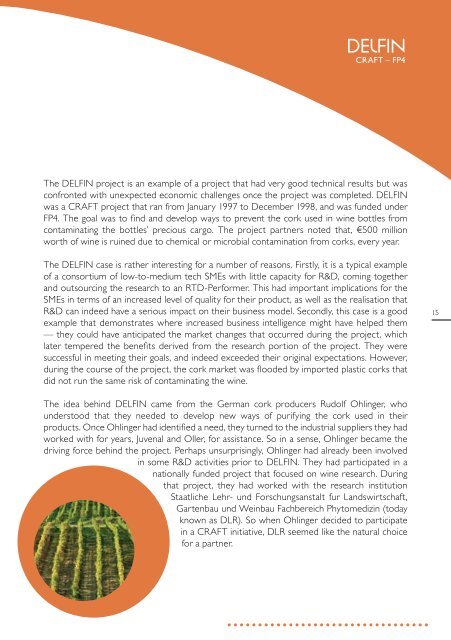SMEs and Research - European Commission - Europa
SMEs and Research - European Commission - Europa
SMEs and Research - European Commission - Europa
You also want an ePaper? Increase the reach of your titles
YUMPU automatically turns print PDFs into web optimized ePapers that Google loves.
DELFIN<br />
CRAFT – FP4<br />
The DELFIN project is an example of a project that had very good technical results but was<br />
confronted with unexpected economic challenges once the project was completed. DELFIN<br />
was a CRAFT project that ran from January 1997 to December 1998, <strong>and</strong> was funded under<br />
FP4. The goal was to find <strong>and</strong> develop ways to prevent the cork used in wine bottles from<br />
contaminating the bottles’ precious cargo. The project partners noted that, €500 million<br />
worth of wine is ruined due to chemical or microbial contamination from corks, every year.<br />
The DELFIN case is rather interesting for a number of reasons. Firstly, it is a typical example<br />
of a consortium of low-to-medium tech <strong>SMEs</strong> with little capacity for R&D, coming together<br />
<strong>and</strong> outsourcing the research to an RTD-Performer. This had important implications for the<br />
<strong>SMEs</strong> in terms of an increased level of quality for their product, as well as the realisation that<br />
R&D can indeed have a serious impact on their business model. Secondly, this case is a good<br />
example that demonstrates where increased business intelligence might have helped them<br />
— they could have anticipated the market changes that occurred during the project, which<br />
later tempered the benefits derived from the research portion of the project. They were<br />
successful in meeting their goals, <strong>and</strong> indeed exceeded their original expectations. However,<br />
during the course of the project, the cork market was flooded by imported plastic corks that<br />
did not run the same risk of contaminating the wine.<br />
The idea behind DELFIN came from the German cork producers Rudolf Ohlinger, who<br />
understood that they needed to develop new ways of purifying the cork used in their<br />
products. Once Ohlinger had identified a need, they turned to the industrial suppliers they had<br />
worked with for years, Juvenal <strong>and</strong> Oller, for assistance. So in a sense, Ohlinger became the<br />
driving force behind the project. Perhaps unsurprisingly, Ohlinger had already been involved<br />
in some R&D activities prior to DELFIN. They had participated in a<br />
nationally funded project that focused on wine research. During<br />
that project, they had worked with the research institution<br />
Staatliche Lehr- und Forschungsanstalt fur L<strong>and</strong>swirtschaft,<br />
Gartenbau und Weinbau Fachbereich Phytomedizin (today<br />
known as DLR). So when Ohlinger decided to participate<br />
in a CRAFT initiative, DLR seemed like the natural choice<br />
for a partner.<br />
15
















